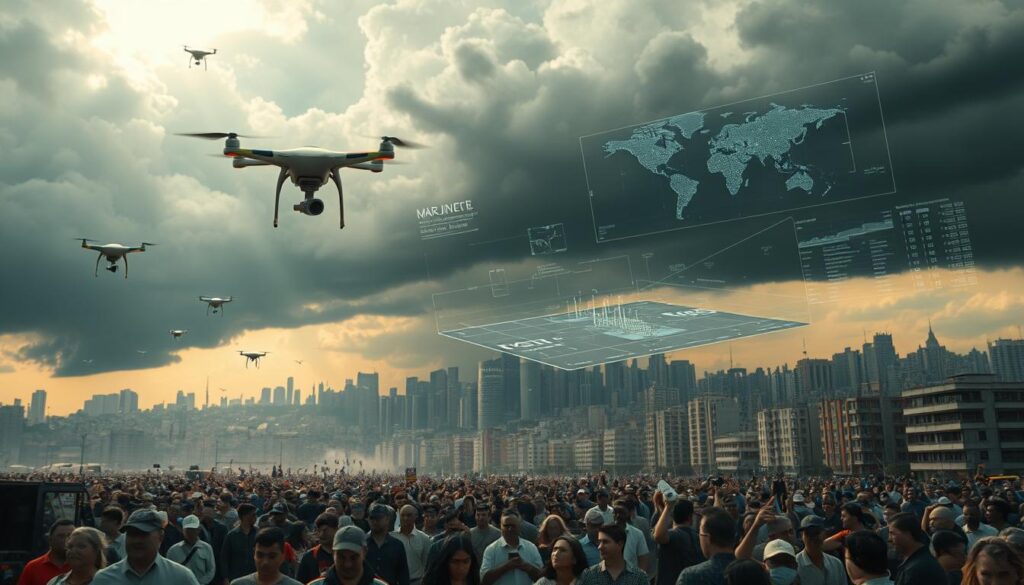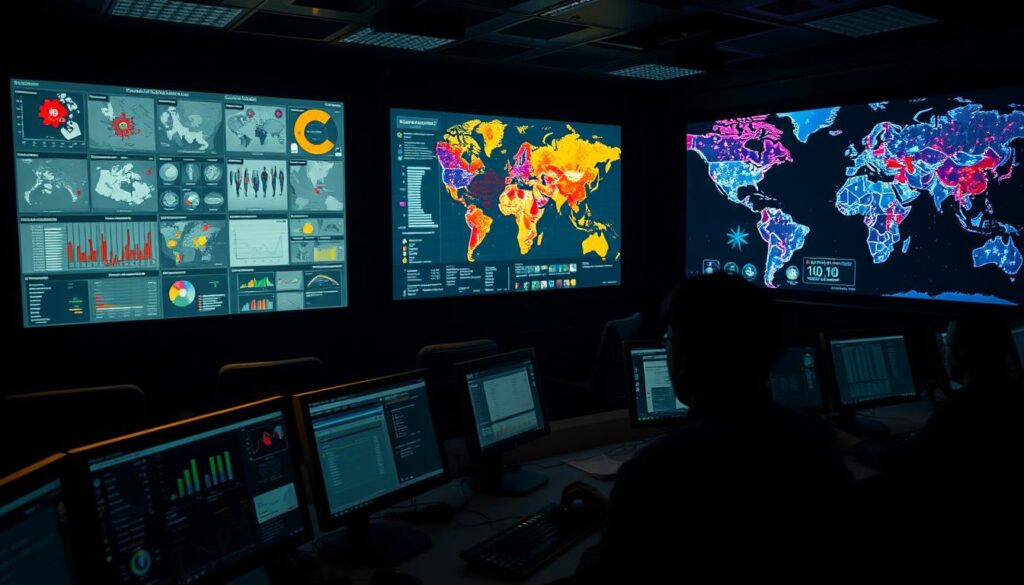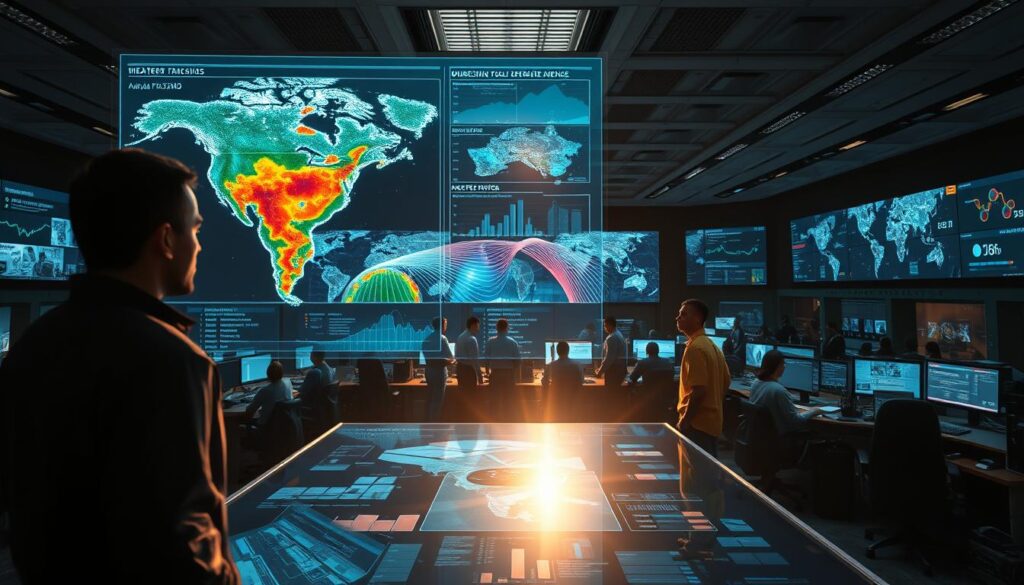“In times of crisis, the right technology can mean the difference between chaos and control.” This quote by a leading tech innovator captures the essence of how advanced systems are reshaping emergency strategies. With climate change intensifying natural events, traditional methods often fall short. New solutions are essential to save lives and protect resources.
Modern tools now predict risks with precision, offering timely alerts. These systems analyze vast data, ensuring resources reach those in need faster. From wildfires to floods, real-time insights improve decision-making. Integration of satellite data enhances predictive capabilities, making responses more effective1.
Emerging technologies optimize evacuation routes and supply chains. Drones and robots navigate hazardous zones, aiding rescue missions. Simulations model various scenarios, preparing teams for challenges. Such innovations reduce recovery times and costs, ensuring communities rebuild stronger2.
Key Takeaways
- Advanced systems predict disasters with high accuracy.
- Real-time data improves resource allocation.
- Drones and robots assist in hazardous environments.
- Simulations prepare teams for diverse scenarios.
- Integration of satellite data enhances predictions.
Introduction to Disaster Response in the Age of AI

Emerging innovations are reshaping crisis strategies, providing faster and more accurate responses. Advanced systems now play a pivotal role in managing emergencies, ensuring resources are allocated efficiently. These tools analyze vast amounts of datum, enabling real-time insights that improve decision-making3.
Multi-agent systems are at the forefront of this transformation. They facilitate rapid information sharing and parallel processing, crucial during critical events. By decentralizing tasks, these tools ensure coordination across teams, even in chaotic environments4.
Overview of AI Capabilities in Emergency Management
Modern technologies excel in data amalgamation, combining diverse sources for comprehensive analysis. This capability allows responders to predict risks with high accuracy. For instance, real-time mapping and situational assessments enhance the speed of emergency actions4.
However, integrating these systems comes with challenges. High upfront costs and operational complexities can hinder adoption. Yet, the potential benefits, such as reduced recovery times and improved outcomes, outweigh these obstacles3.
Evolving Approaches to Crisis Response
Traditional methods often fall short during natural disasters. New strategies leverage advanced technologies to address these gaps. For example, AI-driven simulations model various scenarios, preparing teams for diverse challenges5.
These evolving approaches also focus on scalability. Systems must handle vast amounts of data and complex interactions, ensuring they remain effective in large-scale operations. Learn more about how these innovations are applied in other fields like AI in healthcare.
The Use of AI Agents in Disaster Response and Management

Cutting-edge technologies are redefining crisis management, ensuring quicker and more accurate actions. These systems, known as AI agents, play a vital role in modern emergency strategies. They process vast amounts of information, enabling real-time insights that improve decision-making6.
AI agents stand out due to their ability to analyze complex data swiftly. They leverage advanced technology to predict risks, optimize resource allocation, and streamline communication7. This ensures that affected communities receive timely support during critical moments.
Defining AI Agents and Their Advantages
AI agents are autonomous systems designed to perform specific tasks without human intervention. In emergencies, they collect and analyze data from multiple sources, such as social media, satellite imagery, and ground reports7. This allows them to assess damage extent and identify areas needing immediate attention.
One key advantage is their ability to deliver solutions rapidly. For instance, AI-driven simulations model various scenarios, preparing teams for diverse challenges8. This reduces recovery times and ensures resources are deployed efficiently.
Time and accuracy are critical in emergencies. AI agents excel in both, providing real-time insights that enhance coordination among responders. This ensures that help reaches those in need without delay6.
These systems also improve communication. By processing and disseminating information in real-time, they ensure all teams are on the same page7. This level of coordination is essential during large-scale operations.
In summary, AI agents are transforming disaster response. Their ability to process data swiftly, deliver timely solutions, and enhance communication makes them invaluable in modern emergency management.
The Role of Multi-Agent Systems in Emergency Response

Multi-agent systems revolutionize emergency strategies by enhancing coordination and decision-making. These systems leverage advanced capability to process real-time data, ensuring rapid and accurate responses during crises9.
Real-Time Data Collection and Analysis
One key strength of multi-agent systems is their ability to collect and analyze data in real-time. By integrating machine learning models, these systems process information from diverse sources, such as satellite imagery and ground reports10. This enables responders to assess situations swiftly and allocate resources effectively.
For example, in a simulated environment, agents logged every event and decision, providing valuable insights into evacuation processes10. Such data-driven approaches improve the accuracy of emergency actions, ensuring better outcomes.
Decentralized Coordination Strategies
Decentralized coordination is another critical feature of multi-agent systems. Unlike traditional methods, these systems distribute tasks among autonomous machines, ensuring resilience during failures9. This approach enhances communication and collaboration among teams, even in chaotic environments.
In practice, decentralized strategies have been used to manage evacuation zones, with each area overseen by a designated coordinator10. This ensures that resources are deployed efficiently, reducing response times and improving overall outcomes.
By leveraging these innovative systems, emergency response efforts become more adaptable and effective, saving lives and minimizing damage.
Enhancing Evacuation Planning with AI-Driven Simulations

Advanced simulations powered by intelligent systems are transforming evacuation strategies during emergencies. These tools predict human behavior, assess risks, and optimize routes, ensuring safer and more efficient evacuations11.
Modeling Human Behavior Under Stress
Understanding how people react under stress is critical for effective evacuation planning. Intelligent systems analyze factors like panic and congestion to predict crowd movements12. For example, during the 2019 California wildfires, real-time data helped authorities anticipate evacuation bottlenecks11.
These models also measure the impact of variables such as communication delays and resource shortages. By simulating realistic scenarios, responders can prepare for diverse challenges13.
Optimizing Routes and Resource Allocation
Efficient route planning is essential during emergencies. Intelligent systems process data on traffic flow, population density, and environmental conditions to suggest optimal paths12. In Australia, these tools guided evacuation routes during wildfire seasons, minimizing risks11.
Resource allocation is another key area. Systems analyze damage reports and logistical capabilities to prioritize aid distribution. For instance, during Hurricane Maria, this approach ensured timely support for affected communities11.
By leveraging these technologies, emergency teams can make informed decisions, reducing response times and saving lives13.
Integrating AI with Existing IT Infrastructures for Crisis Management

Integrating advanced systems into existing IT frameworks requires careful planning and execution. Seamless integration ensures that these technologies enhance crisis management without disrupting current operations14. This process involves addressing technical, security, and interoperability challenges to create a robust system.
Overcoming Technical and Security Challenges
One major need is ensuring compatibility between new and existing systems. This often requires significant effort to update legacy infrastructures. Security concerns, such as data breaches and unauthorized access, must also be addressed to protect sensitive information15.
APIs and modular architectures play a crucial role in this integration. They allow systems to communicate effectively, ensuring data flows smoothly between components. Cloud-based services further enhance scalability and flexibility, making it easier to adapt to evolving needs14.
Improving decision-making is another key benefit. Advanced systems analyze data in real-time, providing insights that enhance accuracy and speed. For example, predictive analytics can forecast potential crises, enabling proactive measures16.
Finally, ensuring resilience is essential. IT infrastructures must be compatible with evolving technologies, allowing for continuous improvement. This ensures that systems remain effective in managing complex crises, saving lives and resources14.
Continuous Monitoring and Improvement in Emergency Systems

Effective emergency systems rely on constant updates and improvements to stay ahead of evolving challenges. Continuous monitoring ensures that responders can adapt to dynamic situations, refining processes and strategies in real-time17. This approach enhances overall efficiency and effectiveness during crises.
Iterative Development and Real-Time Adjustments
Iterative development plays a crucial role in emergency systems. By making incremental improvements, teams can address weaknesses and optimize performance. For example, a case study in Florida showed that agent-based modeling improved hurricane evacuation procedures by identifying critical choke points17.
Real-time adjustments are equally important. Systems like SmythOS enable responders to track and analyze agent behavior dynamically, allowing for rapid changes in chaotic environments17. This flexibility ensures that strategies remain effective even as situations evolve.
Leveraging Machine Learning Insights
Machine learning offers actionable insights that adapt to changing conditions. Research at Tsinghua University demonstrated that simulated evacuees in multi-agent systems have unique characteristics, such as age and stress levels, which affect their movement speed17. These insights help refine evacuation plans and resource allocation.
Feedback loops are also essential. Incorporating input from responders leads to more intuitive systems, enhancing decision-making processes17. This collaborative approach ensures that emergency systems evolve to meet future challenges effectively.
Leveraging AI for Predictive Analysis and Early Warnings

Harnessing the power of data, advanced technologies are transforming the way disasters are predicted and mitigated. By analyzing vast datasets, these systems identify patterns that traditional methods often miss. This capability enhances disaster management by providing early warnings, allowing communities to prepare and respond effectively18.
Identifying Disaster Patterns with Big Data
Big data plays a crucial role in understanding disaster patterns. Artificial intelligence algorithms analyze information from satellites, weather stations, and sensors to predict events like hurricanes, earthquakes, and floods18. This predictive analysis offers timely alerts, increasing awareness and enabling proactive measures.
For example, IBM’s Watson AI platform uses meteorological data to forecast hurricane paths and intensities. This technology provides accurate warnings, helping communities prepare for potential impacts19. Similarly, AI-powered drones monitored fire spread during the 2019 Australian bushfires, offering real-time insights that improved resource allocation19.
These systems also enhance emergency response strategies. By identifying areas at risk, responders can allocate resources more efficiently. In Puerto Rico, AI optimized humanitarian aid delivery post-Hurricane Maria, analyzing road conditions and population needs19.
Real-time data feeds are essential for early intervention. AI-driven solutions assess building damage quickly, as seen after the 2017 Mexico City earthquake. This rapid assessment reduces recovery times and ensures timely support for affected communities19.
Ultimately, the integration of AI in predictive analysis not only improves disaster management but also fosters resilience. By foreseeing potential crises, these technologies mitigate impacts, saving lives and resources18. Learn more about how AI enhances emergency preparedness in this detailed analysis.
AI-Powered Communications in Crisis Situations
Innovative communication tools are reshaping how emergency teams collaborate during crises. These systems ensure seamless information sharing, enabling faster and more effective responses. By integrating advanced technologies, organizations enhance their preparedness and coordination during critical events20.
Enhancing Coordination Among Emergency Responders
AI-driven communication platforms streamline data exchange across multiple agencies. This integration ensures that all teams access real-time updates, improving situational awareness21. For instance, during large-scale disasters, these systems prioritize emergency calls based on urgency, reducing response times20.
Advanced tools also provide critical insights by analyzing vast datasets. This capability helps responders allocate resources efficiently, ensuring that aid reaches those in need quickly22. Real-time translation features further enhance communication, enabling non-English speakers to report emergencies effectively20.
Multi-agency cooperation is another key benefit. AI-powered systems act as force multipliers, ensuring all parties have access to the same information. This unified approach minimizes confusion and maximizes efficiency during complex operations21.
By leveraging these technologies, emergency responders can adapt to dynamic situations swiftly. This adaptability not only improves outcomes but also builds resilience within communities22.
Case Studies: Real-World Applications from Wildfires to Hurricanes
Real-world applications of advanced systems during wildfires and hurricanes demonstrate their transformative impact on crisis management. These technologies have proven their ability to adapt to dynamic situations, improving outcomes in high-stakes environments23. From predicting fire spread to optimizing evacuation routes, they offer actionable insights that save lives and resources.
Lessons Learned Through Simulation and Field Application
Simulations play a critical role in preparing for disaster events. During the 2019 California wildfires, real-time data helped authorities anticipate evacuation bottlenecks, reducing response times23. Similarly, AI-driven models forecasted floodwater movements during Hurricane Maria, enabling efficient resource allocation24.
Field applications have also highlighted challenges. For instance, UAVs faced operational and political hurdles during deployment in disaster zones25. These experiences underscore the need for standardized protocols and training to maximize their service potential.
Best Practices in Multi-Agency Collaboration
Effective crisis management relies on seamless coordination among agencies. Multi-agent systems enhance communication, ensuring all teams access real-time updates24. This ability to share information dynamically improves situational awareness and decision-making.
Collaborative efforts during the Beachie Creek Fire, which burned over 402,500 acres, demonstrated the value of integrated systems25. Agencies worked together to prioritize rescue missions and allocate resources efficiently, showcasing the power of unified strategies in large-scale events.
By learning from these experiences, organizations can refine their approaches, ensuring better preparedness for future crises.
Conclusion
Advanced systems have reshaped how crises are managed, offering faster and more precise solutions. By integrating cutting-edge technologies, emergency strategies now achieve higher accuracy and efficiency. Real-time data analysis enhances coordination, ensuring resources reach those in need swiftly26.
Change has driven innovation in crisis response. Platforms like social media play a pivotal role in disseminating urgent information. Collaboration across agency lines ensures a unified approach, improving outcomes during emergencies27.
Future efforts must focus on seamless integration and ethical considerations. Continued advancements will elevate levels of preparedness, making communities more resilient. For more insights, explore AI in disaster management.
FAQ
How does artificial intelligence improve emergency response efforts?
What role do multi-agent systems play in disaster management?
Can AI-driven simulations improve evacuation planning?
What challenges arise when integrating AI with existing IT infrastructures?
How does machine learning contribute to continuous monitoring in emergency systems?
How does AI assist in predictive analysis for early warnings?
What benefits do AI-powered communications offer in crisis situations?
What lessons have been learned from real-world applications of AI in disasters?
Source Links
- Creating Specialized AI Agents For Disaster Management & Mitigation | Projects | Omdena
- No title found
- The Age of Agentic AI
- Artificial Intelligence in Disaster Management: Effectiveness and Challenges
- Electronics
- Applications of Artificial Intelligence in Disaster Management
- No title found
- Powering Your Utility’s Emergency Response with AI
- A Multi Agent Based Approach for Prehospital Emergency Management
- Use of Agentic AI in Disaster Management and Emergency Response [2025]
- AI in Action: Redefining Disaster Preparedness and Financial Security | NAFCU
- Ai For Disaster Response Llm Applications | Restackio
- No title found
- Ai Projects For Emergency Management | Restackio
- Toward an Integrated Disaster Management Approach: How Artificial Intelligence Can Boost Disaster Management
- SmythOS – Utilizing Multi-Agent Systems in Disaster Management
- Leveraging AI for Disaster Response and Management: A New Era of Resilience
- Harnessing AI for Disaster Management: Revolutionizing Response and Recovery
- How Can AI Improve Emergency Response
- Generative AI is set to transform crisis management
- Real-Time AI for Crisis Management: Responding Faster with Smarter Systems
- 5 AI Solutions for Streamlining Logistics Order Management
- Optimising disaster response opportunities and challenges with Uncrewed Aircraft System (UAS) technology in response to the 2020 Labour Day wildfires in Oregon, USA
- AI and Disaster Management: potential and applications – About Resilience
- AI’s Role in Revolutionizing Disaster Management







